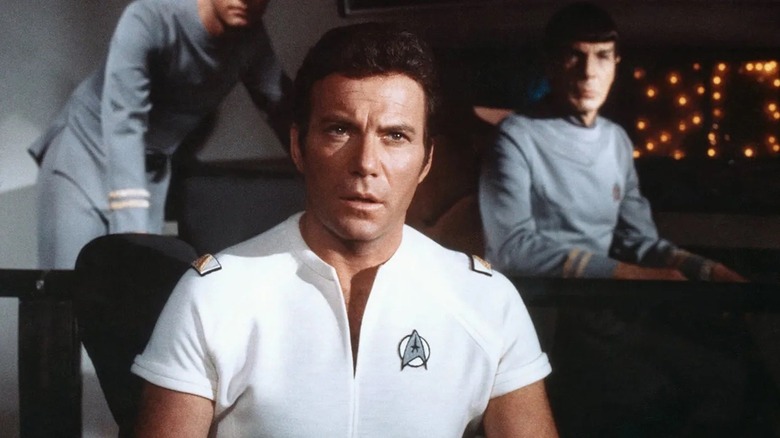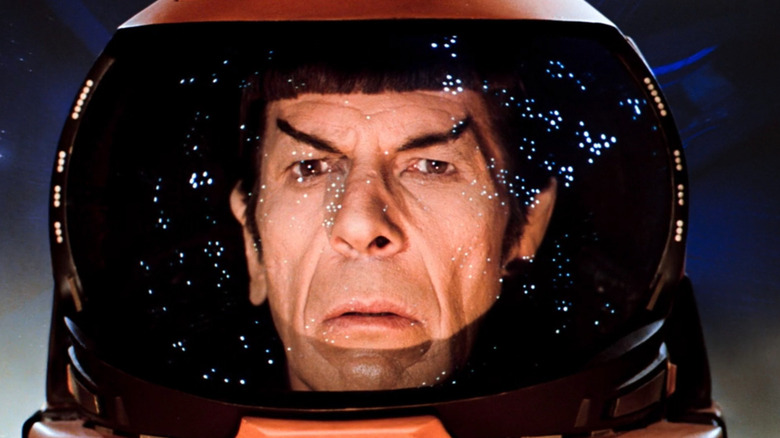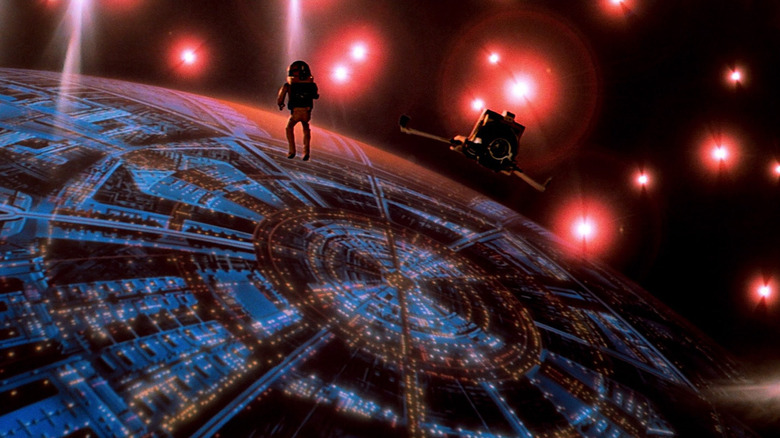Star Trek: The Motion Picture Had To Redo The Spacewalk Scene In Very Little Time
When Gene Roddenberry began developing the screenplay for "Star Trek: The Motion Picture" in 1975, expectations for how a science fiction film could look and feel were rapidly shifting. "2001: A Space Odyssey" offered moviegoers a 70mm trip to outer space, while "The Omega Man," "Soylent Green," and the "Planet of the Apes" series fed off the sociopolitical tumult of the times to thrust audiences into dystopian futures of our own foolish making.
Where did a show that was, at its core, a dream of racially and ethnically inclusive space exploration fit in an era of consciousness-raising spectacle and pessimistic earthbound forecasting? Though the series had failed to enthrall a sizable enough viewership to survive more than three seasons during its initial run on NBC in the late 1960s, "Star Trek" had become popular in syndication with 1970s couch potatoes. There was clearly a hunger for more, and there weren't any movies that hit its brainy/pulpy/hopeful sweet spot.
Then "Star Wars" and "Close Encounters of the Third Kind" happened. By the time "Star Trek: The Motion Picture" commenced principal photography on August 7, 1978, director Robert Wise and his creative team had a new, toweringly high bar to clear both narratively and visually.
Were they successful? We're still having that debate (though most hardcore Trekkers have come around on the movie), but at the time of its release on December 7, 1979, the majority of critics and paying moviegoers could agree that the visual effects were stunning. That Douglas Trumbull, who'd revolutionized optical effects with "2001: A Space Odyssey," would ace this assignment was hardly surprising. But delivering that awe wasn't the smoothest of processes behind the scenes. In fact, one pivotal sequence was almost a cheesy-looking disaster until Trumbull fixed it at the last second.
A completely unusable sequence in a post-Star Wars world
In a 2019 interview with TrekMovie.com, Trumbull revealed that Spock's spacewalk sequence, wherein he makes contact with mysterious entity V'Ger, was initially shot by Wise. When Trumbull (who, as the special photographic effects director, would be on the hook for all of the visuals in the film) took a look at the scene, he was appalled. As Trumbull told TrekMovie:
"I thought the whole thing just looked completely unusable and just not serviceable at all. Badly lit, badly designed, and it just looked like guys hanging on wires. And this was before the more present-day of wire removal and a lot of stuff we could do digitally. They just didn't pay any attention to weightlessness or any of the things associated with that."
Trumbull, whose integral contributions to "Close Encounters of the Third Kind" had recently earned him an Academy Award nomination for Best Visual Effects (which he lost to the "Star Wars" team), immediately asked Wise a serious question. For a film with a then-massive $44 million budget, Trumbull couldn't allow something this clunkily old school to make the final cut. So, with time running out in post-production, he asked Wise to let him reshoot the entire scene. How would Wise, who had two Best Director Oscars on his shelf (for "West Side Story" and "The Sound of Music"), react to such a bold request?
A last-second save that might've rescued the film from infamy
Some directors would've bristled at such a big ask, but Wise, who'd worked with Trumbull on 1971's "The Andromeda Strain," had no qualms with handing the scene over to the visual effects pioneer. Per Trumbull:
"[B]ob just had tremendous trust in me to just go ahead and do whatever I felt was necessary to get the movie done. And he was not comfortable with visual effects, we didn't have much of a dialogue about it. We redesigned and re-imagined the entire spacewalk sequence with Spock. He saw the storyboards and he knew what we were doing but it was quite a challenge to put that whole thing together in such a short period of time."
As someone ancient enough to have seen the film during its first theatrical run, I remember being stunned by Trumbull's work on this set piece and the film in general. 45 years later, I think it's still effective in the context of the movie, though I imagine younger viewers will probably wince at the optical-ness of these outmoded effects. So be it. Most would agree it beats the trousers off most of "The Next Generation" flicks.
Trumbull's achievement was impressive enough at the time to earn him another Best Visual Effects nomination at the Oscars. Alas, he lost in a very competitive year to "Alien" (which also beat out "1941," "The Black Hole" and "Moonraker"). Though Trumbull never won a competitive Oscar, he did earn a Scientific and Engineering Oscar in 1993 for designing the CP-65 Showscan Camera System and a Gordon E. Sawyer Award in 2012. He was also worshiped by every movie buff who grew up dazzled by his pioneering effects, so he was far from an unsung genius.


